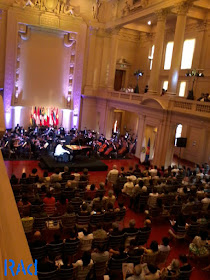Raul
Sunico, piano
Philippine
Philharmonic Orchestra
Herminigildo
Ranera, conductor
Programme:
Pyotr
Ilyich Tchaikovsky
Polonaise from Eugene Onegin, Op. 24
Piano Concerto No. 2 in G major, Op.44
Piano Concerto No. 3 in E flat major, Op.
75
Piano Concerto No. 1 in B flat minor, Op.
23
Pianist
Raul Sunico accomplished an unprecedented feat as he performed three of Pyotr
Ilyich Tchaikovsky’s piano concertos in a single concert held at the Old Senate
Hall of the National Museum of the Philippines.
Accompanied by the Philippine Philharmonic Orchestra led by its associate
conductor Herminigildo Ranera, the fundraising concert presented by the Asian Institute of Management (AIM) raised more than P6 million in donations and pledges
for the AIM-Felipe B. Alfonso President’s Fund.
The
concert featured an all Tchaikovsky lineup opening with the orchestra’s
rendition of the Polonaise from Eugene
Onegin, Op. 24, a great piece to start the event since the stateliness of
the polonaise dance perfectly matched the historic Old Senate Hall that was
just restored to its full glory back in 2012. Then pianist Raul Sunico went on
stage to perform the first of the three Tchaikovsky piano concertos to be performed
which was the Piano Concerto No. 2 in G
major, Op.44. Rarely performed, this concerto has one of the most unique
middle sections as the concertmaster and the principal cellist play significant
solos alongside the piano making it almost a concerto for a piano trio.
The
second half of the concert had Sunico and the PPO performing the one movement Piano Concerto No. 3 in E flat major, Op. 75.
Posthumously published, this concerto originally started as a symphony in E
flat before abandoning that work together. If the second piano concerto is
rarely performed, the third is even more so and I bet that majority in the
audience got to hear this piece for the first time during this concert. The very
popular Piano Concerto No. 1 in B flat
minor, Op. 23 served as the evening’s finale. If the audience didn’t
recognize the third concerto, I’m pretty certain that they’ve heard some parts (the
descending horn intro, the ascending chords by the piano, the string melody one
can hum to, the tranquil middle section with the flute solo, and the exciting
final movement introduced by an accented timpani) of the first before. Probably owing to fatigue, the less than ideal acoustics, and also the weight of the pieces being performed, there were instances where the music wasn't as tight and precise as it could've been, as if the ends were starting to get frayed. But the VIP-filled audience didn't mind for as the piece reached its rousing and exhilarating end, they were immediately up on
their feet showering Raul Sunico, the PPO, and Herminigildo Ranera with
thunderous applause that reverberated throughout the Old Senate Hall.
I
just have to say that the reverb was too much in the hall. I felt that the
microphones used to amplify the sound were unnecessary as it brought about an
overpowering sound. From where I was seated at the left side of the balustrade
level, the lower strings were drowning out the violin sections. And the solo
cello during the second movement of the second concerto was hardly audible. On
several occasions, the piano parts especially during cadenzas, sound very
muddled as if the damper pedal was always pressed.
 |
| RAd and Raul Sunico |
I have to admit that the Old
Senate Hall is not an ideal space in terms of acoustics to stage a classical
music performance. But the architecture, the artwork/sculptures inside, and
most importantly, the history surrounding the hall made for a very fascinating
experience.





No comments:
Post a Comment